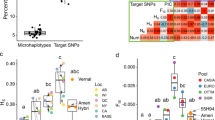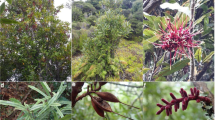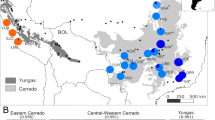Abstract
In the present investigation, I compare the genetic basis of the dissected leaves characterizing two populations of the annual plant Crepis tectorum in the Baltic region, one on the island of Öland (SE Sweden) and the other in the district of Åland (S Finland). Patterns of segregation in crosses using the same simple-leaved plant as a seed parent demonstrate that finely dissected leaves are completely dominant over weakly lobed leaves, that a single major gene may be responsible for the deeply lobed leaves of the Öland population and that three, perhaps four, major genes control leaf dissection in the Åland population. Different dominant genes may be responsible for leaf dissection in the Åland and Öland populations, as shown by the presence of an entire-leaved plant in the F2 progeny of a cross between these populations. These results lend further support to the hypothesis that few genetic changes were involved in the shift from weakly to deeply lobed leaves. Field data from the öland population indicate low penetrance of the single major gene segregating in crosses with simple-leaved populations.
Similar content being viewed by others
Article PDF
References
Andersson, S. 1989a. Variation in heteroblastic succession among populations of Crepis tectorum. Nord J Bot, 8, 565–573.
Andersson, S. 1989b. The evolution of self-fertility in Crepis tectorum (Asteraceae). Pl Syst Evoi, 168, 227–236.
Andersson, S. 1990. A phenetic study of Crepis tectorum in Fennoscandia and Estonia. Nord J Bot, 9, 589–600.
Andersson, S. 1991a. Geographical variation and genetic analysis of leaf shape in Crept tectorum (Asteraceae). Pl Syst Evol, 178, 247–258.
Andersson, S. 1991b. Quantitative genetic variation in a population of Crepis tectorum ssp. pumila (Asteraceae). Biol J Linn Soc, 44, 381–393.
Andersson, S. 1992. Phenotypic selection in a population of Crepis tectorum ssp. pumila (Asteraceae). Can J Bot, 70, 89–95.
Andersson, S. 1993a. Morphometric differentiation, patterns of interfertility, and the genetic basis of character evolution in Crepis tectorum (Asteraceae). Pl Syst Evol, 184, 27–40.
Andersson, S. 1993b. Population differentiation in Crepis tectorum (Asteraceae): patterns of correlation among characters. Biol J Linn Soc, 49, 185–194.
Babcock, E B. 1947. The genus Crepis I-II. University of California Press, Los Angeles.
Charlesworth, B. 1992. Evolutionary rates in partially self-fertilizing species. Am Nat, 140, 126–148.
Cohan, F M. 1984. Can uniform selection retard random genetic divergence between isolated conspecific populations? Evolution, 38, 495–504.
Collins, J L. 1924. Inheritance in Crepis capillaris. III. Nineteen morphological and three physiological characters. Univ Calif Publ Agric Sci, 2, 249–296.
Devicente, M C, and Tanksley, S D. 1993. QTL analysis of transgressive segregation in an interspecific tomato cross. Heredity, 134, 585–596.
Doebley, J, and Stec, A. 1991. Genetic analysis of the morphological differences between maize and teosinte. Genetics, 129, 285–295.
Dorweiler, J, Stec, A, Kermicle, J, and Doebley, J. 1993. Teosinte glume architecture 1: a genetic locus controlling a key step in maize evolution. Science, 262, 233–235.
Fenster, C B, and Barrett, S C H. 1994. Inheritance of mating-system modifier genes in Eichhomia paniculata (Ponte-deriaceae). Heredity, 72, 433–445.
Fisher, R A. 1958. The Genetical Theory of Natural Selection, 2nd edn. Dover, New York.
Givnish, T J. 1987. Comparative studies of leaf form: assessing the relative roles of selective pressures and phylogenetic constraints. New Phytol (Suppl.), 106, 131–160.
Gottlieb, L D. 1984. Genetics and morphological evolution in plants. Am Nat, 123, 681–709.
Grant, V. 1975. Genetics of Flowering Plants. Columbia University Press, New York and London.
Haldane, J B S. 1924. A mathematical theory of natural and artificial selection. Trans Camb Phil Soc, 23, 19–41.
Jackson, L L, Dewald, C L, and Bohlen, C C. 1992. A macro-mutation in Tripsacum dactyloides (Poaceae): consequences for seed size, germination, and seedling establishment. Am J Bot, 79, 1031–1038.
Johnson, C. 1976. Introduction to Natural Selection. University Park Press, Baltimore.
Lande, R. 1981. The minimum number of genes contributing to quantitative variation between and within populations. Generics, 99, 541–553.
Lande, R. 1983. The response to selection on major and minor mutations affecting a metrical trait. Heredity, 50, 47–65.
Macnair, M R. 1976. The Genetics of Copper Tolerance in Mimulus guttatus (Scrophulariaceae). Phd Thesis, University of Liverpool.
Macnair, M R. 1977. Major genes for copper tolerance in Mimulus guttatus. Nature, 268, 428–430.
Macnair, M R, Cumbes, Q J, and Meharg, A A. 1992. The genetics of arsenate tolerance in Yorkshire fog, Holcus lanatus L. Heredity, 69, 325–335.
Mayer, S S, and Charlesworth, D. 1992. Genetic evidence for multiple origins of dioecy in the Hawaiian shrub Wikstroemia (Thymeleaceae). Evolution, 46, 207–215.
Miller, J G, Baker, L R, and Penner, D. 1973. Inheritance of tolerance to chloramber-methyl-ester in cucumber. J Am Soc Hort Sci, 98, 386–389.
Orr, H A, and Coyne, J A. 1992. The genetics of adaptation: a reassessment. Am Nat, 140, 725–742.
Patterson, A H, Damon, S H, Hewitt, J, Zamir, D, Rabinowitch, H, Lincoln, S, Lander, E, and Tanksley, S. 1991. Mendelian factors underlying quantitative traits in tomato: comparison across species, generations and environments. Genetics, 127, 181–197.
Prazmo, W. 1965. Cytogenetic studies on the genus Aquilegia, III. Inheritance of the traits distinguishing different complexes in the genus Aquilegia. Acta Soc Bot Pol, 34, 403–437.
Schat, H, Kuiper, E, Bookum, W M, and Vooijs, R. 1993. A general model for the genetic control of copper tolerance in Silene vulgaris: evidence from crosses between plants from different tolerant populations. Heredity, 70, 142–147.
Van Houten, W, Van Raamsdonk, L, and Bachmann, K. 1994. Intraspecific evolution of Microseris pygmaea (Asteraceae, Lactuceae) analyzed by cosegregation of phenotypic characters (QTLs) and molecular markers (RAPDs). Pl Syst Evol, 190, 49–67.
Whitaker, T W. 1944. The inheritance of certain characters in a cross of two American species of Lactuca. Bull Torrey Bot Club, 71, 347–355.
Wright, S. 1968. Evolution and the Genetics of Populations, vol 1, Genetic and Biometrie Foundations. University of Chicago Press, Chicago.
Acknowledgements
Acknowledgements H. C. Prentice provided valuable comments on the manuscript. Technical assistance by Rune Svensson is also acknowledged.
Author information
Authors and Affiliations
Rights and permissions
About this article
Cite this article
Andersson, S. Differences in the genetic basis of leaf dissection between two populations of Crepis tectorum (Asteraceae). Heredity 75, 62–69 (1995). https://doi.org/10.1038/hdy.1995.104
Received:
Issue date:
DOI: https://doi.org/10.1038/hdy.1995.104



